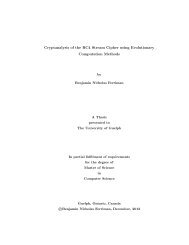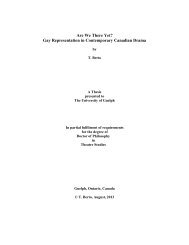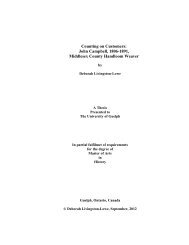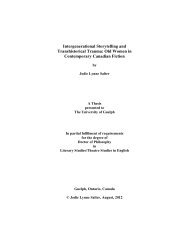THESIS - ROC CH ... - FINAL - resubmission.pdf - University of Guelph
THESIS - ROC CH ... - FINAL - resubmission.pdf - University of Guelph
THESIS - ROC CH ... - FINAL - resubmission.pdf - University of Guelph
You also want an ePaper? Increase the reach of your titles
YUMPU automatically turns print PDFs into web optimized ePapers that Google loves.
Similar to Section 4.4.5, dominating areas <strong>of</strong> interest can be identified. The broad band<br />
around 3000 to 3500 cm -1 is associated with free and bound water with O-H and N-H groups<br />
(Guerrero and de la Caba 2010; Lodha and Netravali 2005). As discussed previously,<br />
increasing RH broadens this region due to the increased hydrogen bonds formed binding water<br />
to the films. Glycerol is strongly detected at frequencies <strong>of</strong> 1040 cm -1 (C-O linkage in C1 and C3<br />
<strong>of</strong> glycerol), and 1117 cm -1 (stretching <strong>of</strong> C-O in C2) (Lodha and Netravali 2005). This large<br />
presence <strong>of</strong> glycerol expectedly dwarfs any detectable C-O vibrations found from cellulose<br />
(Alemdar and Sain 2008). The main absorption peaks <strong>of</strong> Amide I, Amide II, and Amide III can<br />
be seen at 1630 cm -1 , 1540 cm -1 , and 1230 cm -1 (Lodha and Netravali 2005; Schmidt et al.<br />
2005). These bands are associated with C=O stretching, N-H bending, and C-N stretching<br />
respectively. Interaction between cellulose and SPI would affect the protein structure and could<br />
be elucidated via these regions. Changes found within the Amide I and Amide II bands have<br />
been strongly correlated to the secondary structure due to the absence <strong>of</strong> interference with<br />
other vibrations (Barth 2007). Determining structural changes with the Amide III band is more<br />
complicated due to side chain contributions (Barth 2007). However, predictions on secondary<br />
structure have been previously made using the Amide III band (Cai and Singh 2004). Figure<br />
6.10, Figure 6.11, and Figure 6.12 further analyzes the Amide I, II, III bands for evidence <strong>of</strong><br />
structural changes.<br />
81

















